MV Kate, Tiger Beach, The BahamasContents of this Issue: MV Kate, Tiger Beach, The Bahamas Scuba Diving In His Living Room? Papua Explorers, Raja Ampat, Indonesia Three More Popular Wrecks Lost Forever Toilet Paper, Dirty Money, Tiny Cockroaches Now Kelp Forests Take a Beating Stop Critter Manipulation Photos Tweaking the Inwater Recompression Protocol A Day in the Chamber and I Wasn’t Bent Those Dreaded Liability Waivers Checking the Internet While Diving Editorial Office: Ben Davison Publisher and Editor Undercurrent 3020 Bridgeway, Suite 102 Sausalito, CA 94965 don’t forget, you are still prey from the March, 2017 issue of Undercurrent
Dear Fellow Diver: On my fourth day of diving at Tiger Beach -- that's the once "secret" spot in the Bahamas where one is all but certain to be face-to-face with tiger sharks -- I made a mistake that could have hurt me, seriously hurt me. And then some. I was only 45 feet (14m) deep, wearing 22 pounds (10kg) of lead to stay down because of the expected currents, but there was no current. Three active tiger sharks buzzed around as the dead fish smell was everywhere. I pulled my housed Olympus OMD with dual strobes toward me to photograph an approaching tiger chasing a fish our shark wrangler had tossed, but she missed the bait, and in the blink of an eye, she transformed from scavenger to predator and came at me. Our shark wrangler moved quickly to push her away. But, "Butters," an 11-footer (3.5m), turned around and came back again, this time chomping down on the strap between the two strobe arms and swimming away with my camera rig before dropping it a few feet away. I retrieved my camera, but she came back at me again, then again, and again, and each time I pushed her away. Unnerved, I headed to the surface to end the dive. She followed me up a ways, before returning to the feed.
On January 29, I had boarded the MV Kate in Freeport, Grand Bahamas Island, which departed for Tiger Beach once all the guests had arrived. While their website claims this is the "finest in luxury diving charterers," don't you believe it. Indeed, everyone sleeps in one dormitory area, where there are four single bunk/sleepers and two double bunk/sleepers, with only small curtains for privacy. Climbing in and out of the bunk left me with a knot on my head, as the 30-inch (75cm) clearance was just not enough for night-time bathroom calls (it would have been impolite to turn on an overhead light). Complicating matters, the floor is the only storage area, so having to negotiate everyone's luggage in choppy seas was no easy matter. The first night, the weather was drizzly, windy, and cold, and the 30-mile crossing was rough. Of the seven divers aboard, three became seasick and hit their bunks early. I lasted until dinner, when the smell of chicken cutlets frying in oil did me in. Nauseated, I adjourned to my bunk as well. With 12 people, including crew, on the boat, the two bathrooms -- one in the dorm area, the other on the main deck near the kitchen/dining area -- got a workout, as they did again after dives when divers lined up to shower. The MV Kate's crew also consisted of Captain Scotty, his son and mate, Brady, Margarita, the chef, and two experienced shark-feeders, Mike, a Texan, and Jamin Martinelli, who leads inwater Pilates for seniors when she's not wrangling. Both have appeared on the Discovery Channel Shark Week programs with Joe Romerio and have worked with shark scientists from several universities. That said, their initial briefing was short and succinct, such that I didn't grasp the meaning and objective of their instructions to keep our arms out in front, with the camera between the shark and us. I learned, but too late.
Our original plan was to dive Tiger Beach for two days, travel overnight to Bimini for two days with hammerheads, and then return to Tiger Beach for the final day. Unbeknownst to any of us prior to arriving at Tiger Beach, Bimini was hosting a fishing tournament, we were told, and that would attract bull sharks as well as hammerheads, so rather than be in the water with fishermen chumming bait, we opted to stay at Tiger Beach, where we hoped a hammerhead or two might appear.
Tuesday morning, the diving commenced. Because of the shallow depth, the diving was pretty much all day long, as one shark feeder would descend, stay down for 90 minutes, then be replaced by the other. The Tiger Beach bottom is 22 feet (7m) down, and there was usually a heavy current, but one day it was dead calm, so sharks streamed in from everywhere. At the other site, 45 feet (14m) deep, we had the reef behind us -- and the current, which pushed us forward -- as we made a V-formation beginning from the bait box, from which the handlers pulled fish to feed the sharks. Smelling the fish, the sharks came from up-current, forming a conveyor belt as they headed to the bait. That first dive, I only saw reef and lemon sharks, but I didn't take my camera so I could test the currents and learn how the animals reacted. The water was clear and 74°F (23°C), and I wore my snug 5mm wetsuit that kept me warmer than those who were in 7mm poor-fitting wetsuits. So that exiting would be quick and easy, the shark feeders kept us close to the boat, but moved the bait box frequently. I kept up with them in the stiff current by crawling, since I could not swim with 30lbs (13kg) of lead. I got my exercise on the trip for sure!
On day three, we dove the shallow area in the morning and then moved to the 45-foot-deep reef, where, on my 600th dive, two tiger sharks and the sole hammerhead of the week showed up to congratulate me. On the reef, I cut my lead by eight pounds (3.5kg) because I could stay steady with lighter weight at that depth. Still, trucking around with either 22 or 30 pounds (10 or 13kg) added to my current fatigue, so I made just eight dives in four days, averaging 47 minutes. But they were, indeed, action-filled dives. A few guests made four a dives a day, while one diver seemed oblivious to it all, unable to get anything together on time, and once jumped in after the divers were already on the bottom, then swam around for 20 minutes with tiger sharks on the prowl and was unable to find them. Once, Mike sent her up because her computer was headed into the red; she skipped the safety stop. On the last two days, we stayed at the deeper reef, hoping the hammerhead would return. While as many as four tigers visited at a time, the hammerhead never came back, although a bull shark hung out at the edge of my sight. Of course, reef sharks and lemon sharks were everywhere, and several black groupers hung around. So thick in numbers were the yellowtail snappers, they sometimes blocked the feeders from seeing the tigers approach. And, it was here that Butters came at me.
That evening, the boat moored an hour out from Grand Bahamas Island. Saturday morning, the seas were dead calm, and after breakfast we packed our gear, arriving at the dock at 11 A.M., where cabs were waiting. I left, satisfied that I had the photos I wanted, and my arms were intact. PS: While divers have love affairs with sharks, we sometimes forget they are wild predators. Nearly 10 years ago, an Austrian lawyer, Markus Groh, died after a tiger shark bit him at a Tiger Beach feed. Even the legendary Jim Abernethy was bitten by a lemon shark there. There will be others. -- P.S. Our undercover diver's bio: "I started diving in 1999 because I was sure the world would end in 2000, so I figured, 'Why not, I could only drown.' Later, I committed the heinous crime of taking up underwater photography, and, obsessed with capturing critter behavior, I've buzzed around the Caribbean, where I've made most of my 600 dives (I've also dived in the Philippines). Photography has helped my fish, critter and coral/sponge ID skills, so now when I'm asked, 'What is that?' I no longer have to say, 'I dunno.'"
|

I want to get all the stories! Tell me how I can become an Undercurrent Online Member and get online access to all the articles of Undercurrent as well as thousands of first hand reports on dive operations world-wide
| Home | Online Members Area | My Account |
Login
|
Join
|
| Travel Index |
Dive Resort & Liveaboard Reviews
|
Featured Reports
|
Recent
Issues
|
Back Issues
|
|
Dive Gear
Index
|
Health/Safety Index
|
Environment & Misc.
Index
|
Seasonal Planner
|
Blogs
|
Free Articles
|
Book Picks
|
News
|
|
Special Offers
|
RSS
|
FAQ
|
About Us
|
Contact Us
|
Links
|
3020 Bridgeway, Ste 102, Sausalito, Ca 94965
All rights reserved.

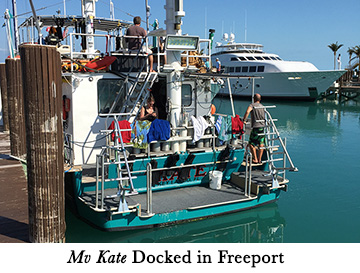 After the dive, Mike Black, who has 10 years' experience as a shark wrangler, explained what Butters was doing. By pulling my camera back, he said, I caused her to become a predator, and I was her target because she perceived me as running away, as prey do. I managed to remain calm with his explanation, but the incident preyed upon my mind all night. So much for anthropomorphizing a half-ton tiger shark with the cute name "Butters." Jaws would be better.
After the dive, Mike Black, who has 10 years' experience as a shark wrangler, explained what Butters was doing. By pulling my camera back, he said, I caused her to become a predator, and I was her target because she perceived me as running away, as prey do. I managed to remain calm with his explanation, but the incident preyed upon my mind all night. So much for anthropomorphizing a half-ton tiger shark with the cute name "Butters." Jaws would be better.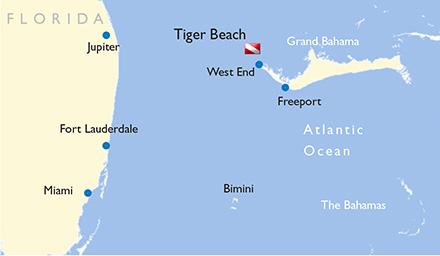 While most of the divers come to photograph, the MV Kate has no separate room for camera gear. Photographers took over the dining room, which consisted of booths, a table and chairs, and set cameras and gear everywhere, including on towels on the floor. Because spots for charging batteries were at a premium, they should have forewarned us to bring a media bridge to hook up both chargers for our camera battery and strobes, as well as items such as focus lights. In fact, the entire craft was cramped, leaving the marine heads as the only place for privacy, and you sure didn't want to stay in those smelly places long.
While most of the divers come to photograph, the MV Kate has no separate room for camera gear. Photographers took over the dining room, which consisted of booths, a table and chairs, and set cameras and gear everywhere, including on towels on the floor. Because spots for charging batteries were at a premium, they should have forewarned us to bring a media bridge to hook up both chargers for our camera battery and strobes, as well as items such as focus lights. In fact, the entire craft was cramped, leaving the marine heads as the only place for privacy, and you sure didn't want to stay in those smelly places long. 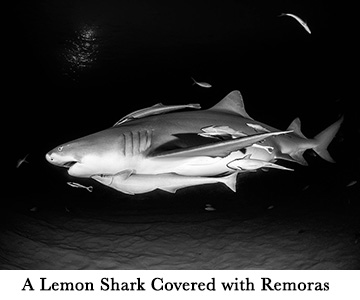 Unfortunately, high winds and a stiff current caused us to skip diving the first day, so we worked on camera gear, watched a short video, napped, talked about sharks, and wondered if the new administration might gut the Endangered Species Act, as many speculate. The guests included an American couple, a Swedish marine biologist living in Australia and her friend who manages a Caribbean dive shop, a female attorney, and the trip organizer, Tanya Houppermans (Blue Elements Imaging) -- an award-winning photographer.
Unfortunately, high winds and a stiff current caused us to skip diving the first day, so we worked on camera gear, watched a short video, napped, talked about sharks, and wondered if the new administration might gut the Endangered Species Act, as many speculate. The guests included an American couple, a Swedish marine biologist living in Australia and her friend who manages a Caribbean dive shop, a female attorney, and the trip organizer, Tanya Houppermans (Blue Elements Imaging) -- an award-winning photographer.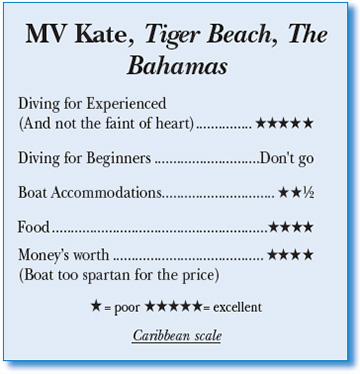 And that exercise helped burn calories as Margarita cooked up good, home-style
meals -- in fact, creating two menus for each meal, as four guests were vegans.
Breakfast were eggs, usually fruit, fresh muffins or breakfast cakes, and bagels,
toast, cereal, and oatmeal. Lunches were things like chicken and dumplings, or
tacos in her own homemade masa tortillas, while dinners might be pork tenderloin
or flank steak, with sides like salads, green beans, or mashed potatoes. She also
prepared daily deserts and between-dive snacks: carrots, celery sticks, radishes
and a dip, once sausage, cheeses and crackers, another time hand-made chips and
salsa. The Kate carries no alcohol, but divers may bring their own; however, it's
best stored in one's bag on the floor.
And that exercise helped burn calories as Margarita cooked up good, home-style
meals -- in fact, creating two menus for each meal, as four guests were vegans.
Breakfast were eggs, usually fruit, fresh muffins or breakfast cakes, and bagels,
toast, cereal, and oatmeal. Lunches were things like chicken and dumplings, or
tacos in her own homemade masa tortillas, while dinners might be pork tenderloin
or flank steak, with sides like salads, green beans, or mashed potatoes. She also
prepared daily deserts and between-dive snacks: carrots, celery sticks, radishes
and a dip, once sausage, cheeses and crackers, another time hand-made chips and
salsa. The Kate carries no alcohol, but divers may bring their own; however, it's
best stored in one's bag on the floor.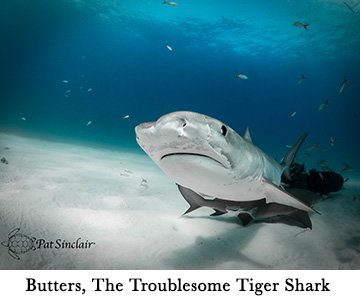 So, the last morning, I had to work through my fear and talk myself into diving, as I was afraid of what another mistake might mean. Knowing I must face my fear, I made one rule and got back into the water. I would not be in the water with more than two tigers at a time. When there was current, they came straight to the bait box in a nice line. But, on this dive, there was no current, and it was hard to keep track of them when they flicked their tails and took off. Regardless, I got fine photos on that dive, so I am delighted I did it. Any time Butters and the other tiger shark became too pushy I just shoved them away with my dome port.
So, the last morning, I had to work through my fear and talk myself into diving, as I was afraid of what another mistake might mean. Knowing I must face my fear, I made one rule and got back into the water. I would not be in the water with more than two tigers at a time. When there was current, they came straight to the bait box in a nice line. But, on this dive, there was no current, and it was hard to keep track of them when they flicked their tails and took off. Regardless, I got fine photos on that dive, so I am delighted I did it. Any time Butters and the other tiger shark became too pushy I just shoved them away with my dome port. Divers Compass: Blue Iguana Charters runs the MV Kate (
Divers Compass: Blue Iguana Charters runs the MV Kate (